The wind was light and patchy that day, with Harold Bennett waiting for the breeze to settle. Alinghi clearly wanted to get on with it, flying a hull right past Bennett’s committee boat. BMW Oracle gave the impression of being rather more reluctant.
With the breeze blowing little more than 3 knots, the countdown sequence commenced, and the boats made ready to enter the start box. Suddenly, the lumbering trimaran came alive as Spithill put USA-17 on to one hull and scythed into the start area at supersonic speed. Alinghi’s approach was late, and slow. Spithill had caught the Swiss napping, and had them fixed in his cross-hairs. The two boats averted a head-on collision with a late dial-up into the breeze.
American tactician John Kostecki flew a flag in protest, and the umpires came back with their decision. Penalty against Alinghi! Matt Mason hadn’t been talking it up after all. Spithill was dead set on bringing traditional match racing aggression into play, no matter what kind of hi-tech science-fiction boats they might be racing.
However, no sooner had Spithill seized the advantage than he threw it away. As both boats slowed to a standstill parallel to each other, the young Australian lost steerage and stalled the trimaran. Bertarelli slipped free of his rival’s clutches, gybing away and recrossing the start line to surge to a commanding lead.
By the time Spithill had regained control of USA-17 and crossed the starting line, Alinghi was already more than 650m ahead. But what happened in the next 10 to 15 minutes was remarkable. It was the defining moment of the 33rd America’s Cup. As Spithill wound USA-17 up to full speed, her central hull lifted out of the water and the boat started sailing faster and almost 5 degrees higher than Alinghi 5, which looked unbalanced and stuttering by comparison.
In less than quarter of an hour the Americans had overturned a 650m deficit and turned it into an advantage of almost 500m. Alinghi might have changed to a smaller headsail in a vain attempt to stop the rot, but it didn’t help much. The wing rig was just plain faster.
By the end of the 20-mile windward leg the Americans were a long way ahead. Downwind back to the finish it only got worse for the Swiss. They crossed the finish line more than 10 minutes behind and by the time they had made a mess of unwinding their pre-start penalty the official Delta was 15 minutes and 25 seconds.

© Manuel Queimadelos Alonso
In the conference afterwards, it was clear the fight had gone out such Butterworth and Bertarelli’s eyes. “The wing is a weapon,” admitted Bertarelli with grudging admiration. He kept on repeating the fact that there was still another race to go. In fact for Alinghi there were two more races to go if they had any intention of making a successful defence of the Cup. But Bertarelli’s repeated faux-pas suggested that he believed the game was already up.
Butterworth made even less secret of his feelings. Asked whether he felt Alinghi had lost the design race, after a long pause the laconic Kiwi replied: “What do you want me to say mate? They sailed from behind us to in front of us.....They couldn’t have come off the line in a worse position, and wound up in a very strong position. When you’re sitting in front of them and they sail up and around you, that’s speed. With an ‘S’.”
Bertarelli and Butterworth also implied that the race had taken place in strong winds, and that they were looking to sail the next race in light breezes. This seems a little strange as the wind never exceeded 8 knots, but it was clear that Alinghi wanted to try to keep the racing as low down the wind range as possible. That was their best hope of negating the advantage of the wing rig.

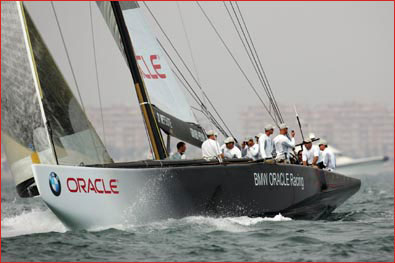 BMW Oracle has been carrying out some extensive TV trials of monohulls and multihulls in Valencia. The aim, says the Defender, is to work out which kind of boat is going to offer the biggest bang for buck in Russell Coutts’s vision of a more media-friendly and commercially-attractive America’s Cup...
BMW Oracle has been carrying out some extensive TV trials of monohulls and multihulls in Valencia. The aim, says the Defender, is to work out which kind of boat is going to offer the biggest bang for buck in Russell Coutts’s vision of a more media-friendly and commercially-attractive America’s Cup...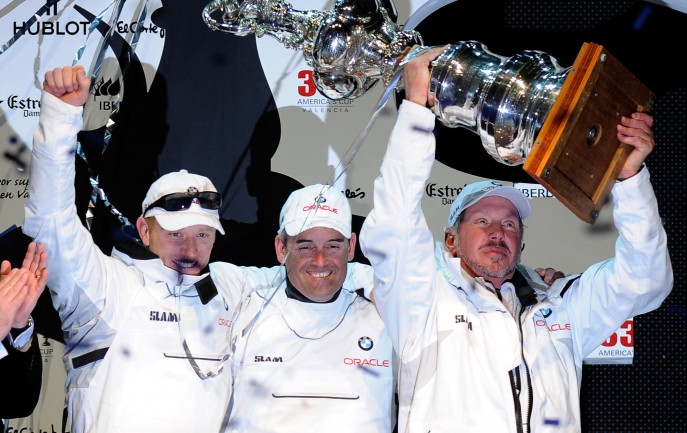 So now we’ve seen the power of wing rigs in action in the America’s Cup, what possibility of a trickledown of technology into other forms of sailing? What about superyachts? BMW Oracle’s design team director Mike Drummond observed, tongue in cheek: “If you go to Wings R Us.com, you can get any size you like.” Of course, this technology is anything but off the shelf, but nor is it new, as Drummond also pointed out: “Wings are not new, they’ve been used by birds for quite a long time...
So now we’ve seen the power of wing rigs in action in the America’s Cup, what possibility of a trickledown of technology into other forms of sailing? What about superyachts? BMW Oracle’s design team director Mike Drummond observed, tongue in cheek: “If you go to Wings R Us.com, you can get any size you like.” Of course, this technology is anything but off the shelf, but nor is it new, as Drummond also pointed out: “Wings are not new, they’ve been used by birds for quite a long time...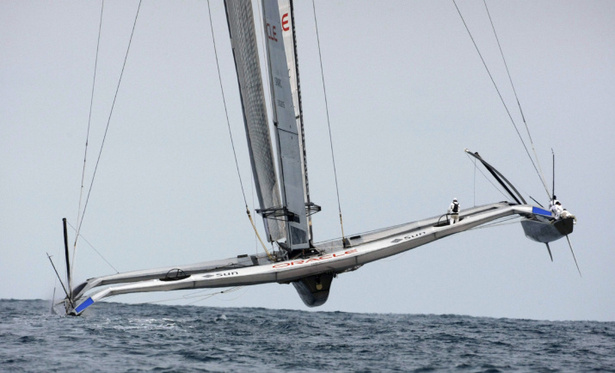 So now we know. Wings trump sails. Theory has always stated that a wing rig should be faster than conventional sails. But the challenge was actually to put a wing rig into practice, to be able to build it in less than six months, and also to manage the logistics of it...
So now we know. Wings trump sails. Theory has always stated that a wing rig should be faster than conventional sails. But the challenge was actually to put a wing rig into practice, to be able to build it in less than six months, and also to manage the logistics of it...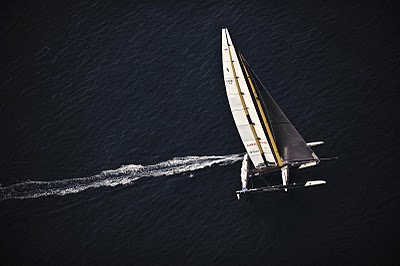 Race 2 was set to take place two days later on the Sunday. It was another long wait while Harold Bennett looked for suitable conditions in which to start the race. The cut-off time of 4pm was just minutes away when Bennett called for the start procedure to begin...
Race 2 was set to take place two days later on the Sunday. It was another long wait while Harold Bennett looked for suitable conditions in which to start the race. The cut-off time of 4pm was just minutes away when Bennett called for the start procedure to begin...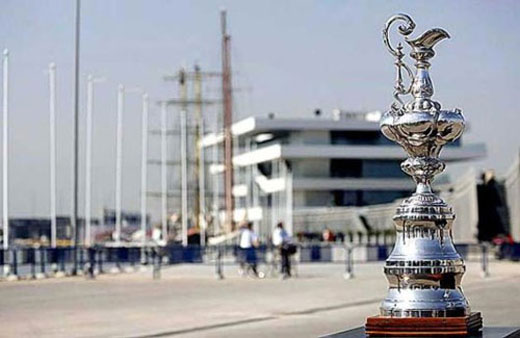 Guessing the outcome of an America’s Cup isn’t meant to be easy, but the majority of pundits seemed so taken by the revolutionary solid wing rig of BMW Oracle racing to do anything other than believe that the Americans would win...
Guessing the outcome of an America’s Cup isn’t meant to be easy, but the majority of pundits seemed so taken by the revolutionary solid wing rig of BMW Oracle racing to do anything other than believe that the Americans would win...